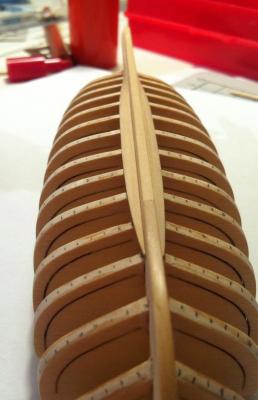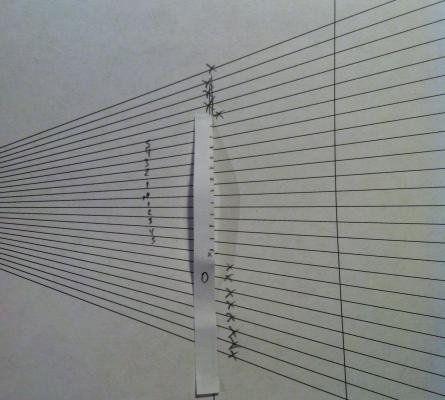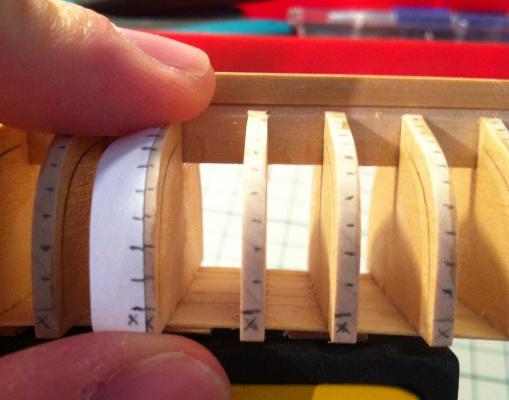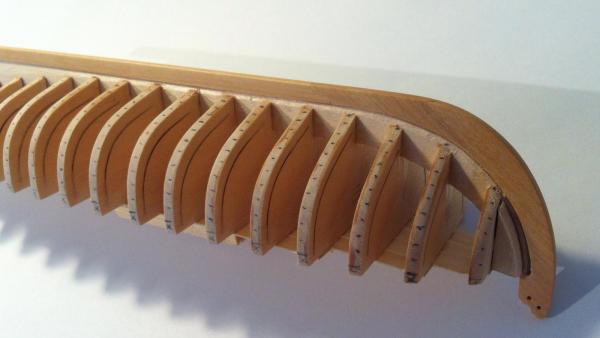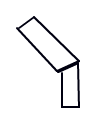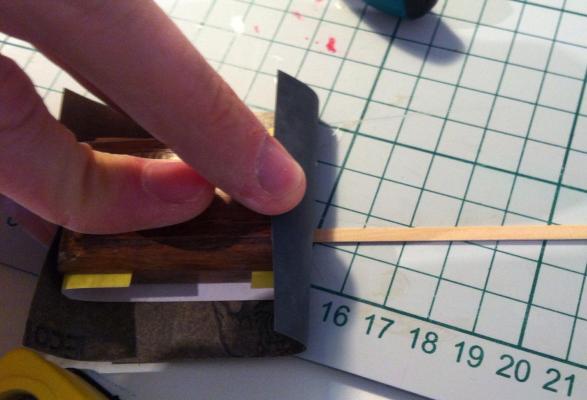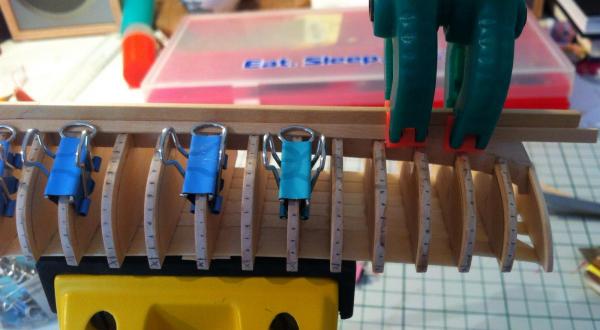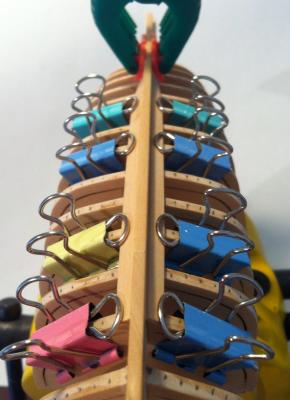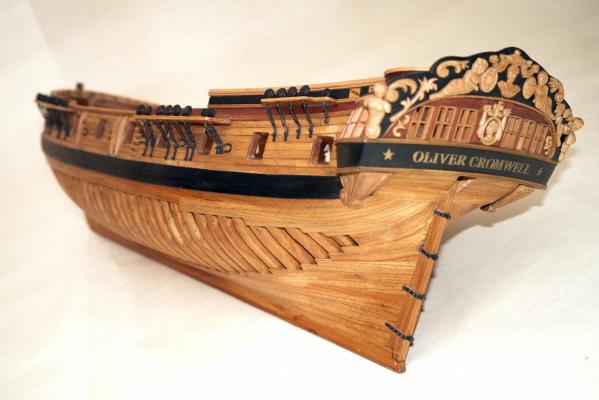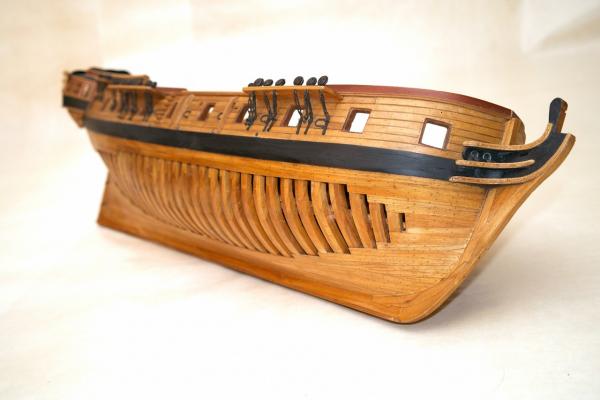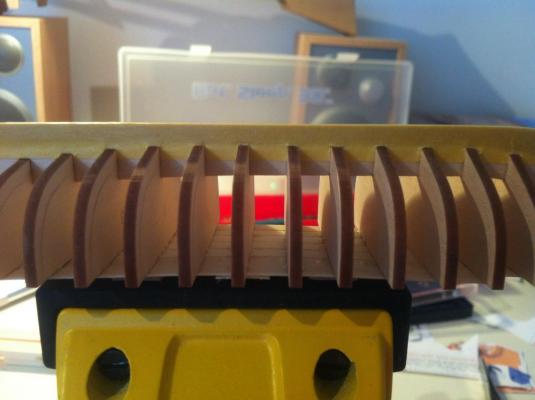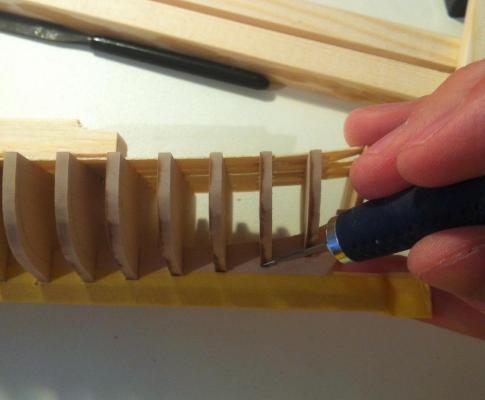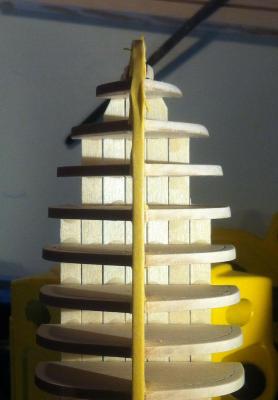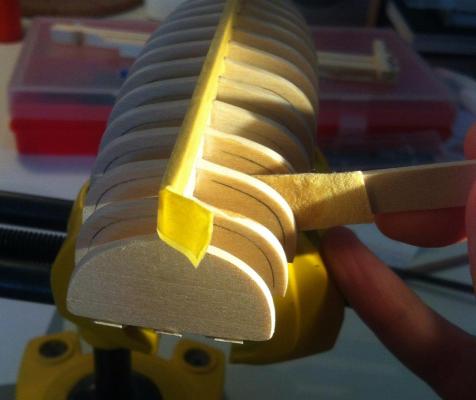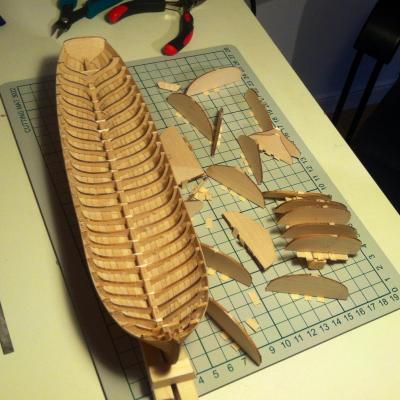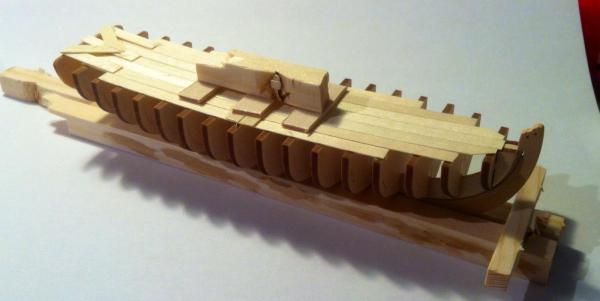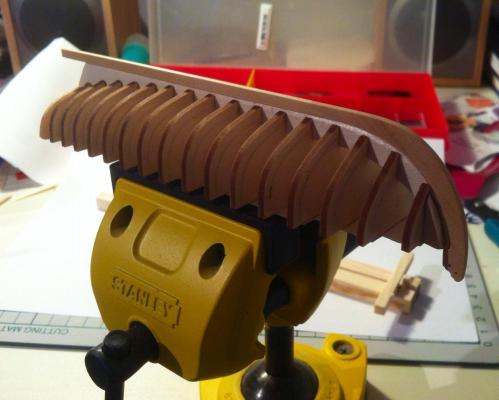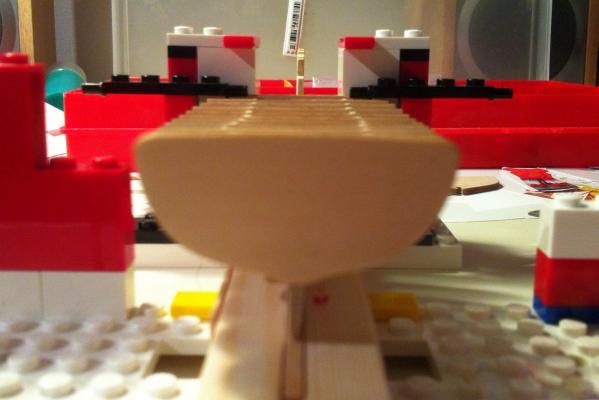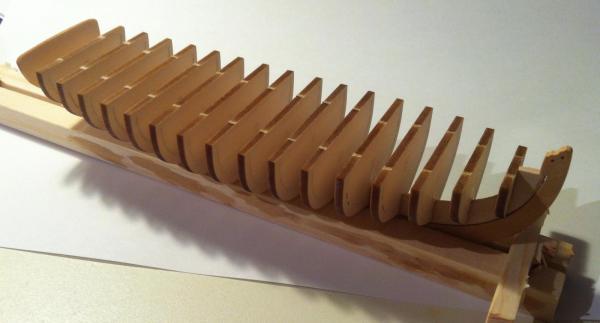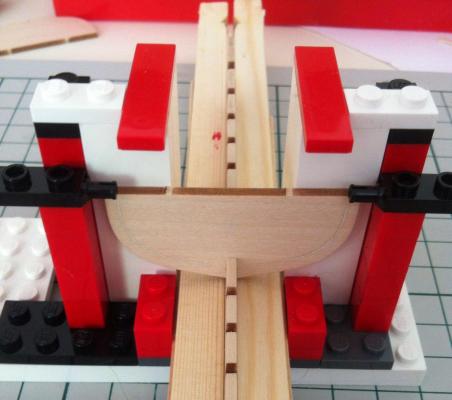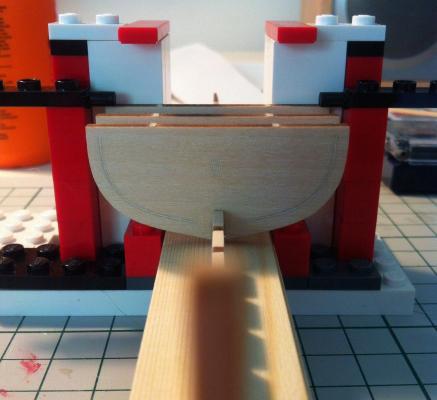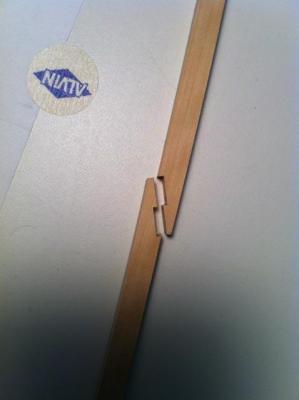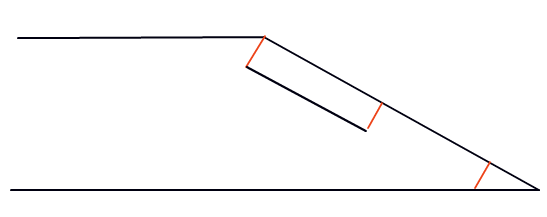-
Posts
1,543 -
Joined
-
Last visited
Content Type
Profiles
Forums
Gallery
Events
Everything posted by Mike Y
-
Yep, Pops, I share your confusion. Spent some time fitting next planks and trying to find what is wrong. So far nothing is wrong, or I lack experience to spot the problem. Whats good with that build - it is just 12 strakes, so if I made a mistake indeed - not a big problem, have enough spare planks and PVA-based glue, which is easily dissolved with water. It is a great planking training platform indeed! And much easier then pinnace - bulkheads are much wider. Anyway, installed the gardboard plank. The curvature is quite smooth, it should help to reduce edge bending.
-
Hi David, Yes, I simply shape it with file and sanding block. Not perfect, but works pretty well. I also glue edges of planks together, so if shaping is not perfect - glue hides it. Also that shaping angle is variable, due to different curvature on different parts of the hull. As for substraction - I also skip planks, if I see that it already terminated before that bulkhead. So I just cut off a piece from the template, and now it have 10 planks, then 9, then 8, etc. The calibration point is a sheer line, not the keel. But, again, I have a feeling that reference lines on a bow are wrong, because there is no taper. Let's see how it goes, I'll probably find the mistake after planking a few strakes.
-
Pops, I used same template, because planks width is the same. Not all planks will reach the top bulkhead, some will terminate earlier. However, I have a gut feeling that my marks on the bow are wrong - everything looks clean and logical, but there would be no taper, according to the marks. So maybe I will adjust them later... Your way of planking also makes sense, but it will look differently (very thin planks at the bow). Less edge bending though.
-
I'm not an expert in planking, and all that methods are created and described by other builders. Highly recommend to read Longboat build logs from Bob F and Stuntflyer, and of course Chuck's manual. Plus there are lots of good tutorials in downloads section on this website. But maybe my photos and description would be useful for somebody, so why not posting them. Decide how many plank streaks are you going to have. Manual suggests 12, Bob was using 13, some people use 11. Pretty much depends on width of your planks and desired "curvature" of a hull. Wrong number of streaks is not a big deal, but if streak width is too small, then you will need to make plank thinner to fit into reference lines. Make a card template for reference lines. Length of a template is equal to length of biggest bulkhead, and it's broken down into 12 parts using template available in downloads section of this website: Mark top plank line. "Default" line is suggested on a plans, and you can adjust it to get a more/less banana-shaped hull. Then, starting from that line, add marks on bulkheads: Now you can easily see the lines of future planks. Not sure I got it right in the bow, I remember that on Pinnace I tapered planks a lot of fit them on a bow. Maybe this time I will avoid it, or my reference lines on a bow are wrong I will start planking from bottom to the top, to have even plank thickness and avoid "meeting" in between. Reference lines will help to make sure that both sides of the hull will be planked symmetrically. Plank edge is shaped to fit with next plank or keel on a proper angle. I think it's very important, otherwise it's really hard to have no gaps. It's a very obvious thing that is not mentioned anywhere, strange. Edge not shaped: Shaped edge: Then I sand inside surface of the plank. It would be very hard to do it later. I use 1200 -> 2000 grits for boxwood, it adds a really nice shine. It makes gluing a bit harder, though. Using sanding block to avoid smoothing plank edges. Then I soak plank in a hot water for 10-20 seconds, shape it gently with hands, and clamp onto the hull. I use a very simple clamps recommended on this forum: http://modelshipworld.com/index.php?/topic/611-easy-planking-clamps For basswood, make sure you put some wood or card between them and planks. For hard wood, that could be not necessary. Notice the bend of gardboard plank closer to stern. Better select a plank with fibers oriented on same angle, then this bend would be easier and plank will not break: I will shape the front part of gardboard plank when it's dry and fit to shape. So now let's leave it for a few hours and have a rest! This method of planking is slow, basically one plank streak on a day. If planks is glued too early - it will shrink and leave a tiny gap.
-
Pops, yes, only in single direction. In the direction how plank is installed (hence it is one direction in front part of the hull, another - in rear part). For the scarf - no, I used dremel cutting disk to start a joint, and then file to shape it accurately. It is hard to cut thick boxwood with just a blade accurately enough.
-
Hi Floyd, About the bulkhead not lining up - not sure I understood the question. I had no such problem, sockets in false keel and frames should be widened a bit with a file, they are too tight. That is on purpose, and as far as I remember - described in a manual (at least, in Pinnace manual). If they are widened - then bullhead can move a bit, and then I used a jig to align them to 90 degrees. Of course, they should not be too loose - otherwise the glue joint will be weak, and bulkhead could be shifted to one side, causing a wrong hull shape. For the poly - I did it after sanding to have a consistent layer of poly closer to outer edge of the frame. It could be damaged while fairing s frame. However, applying poly before gluing frames could be also ok. I strongly believe that there is more then one right way of doing it
-
For Pops - frame fairing. First I protected the nice shiny keel from scratches with a masking tape: Then the idea is simple - sand away all corners, but do not sand too much to avoid skewing frame shape - laser cut char is a handy indicator, tiny strip of char remaining means "ok, enough". Any tools could be used - sandpaper, sanding block, files, whatever is preferred. Just don't rush it, make light passes. It will take an hour or more for each side. Some frames should be trimmed near the false keel: Left side - not faired, right side - faired. Tested the fairing using a plank, it should lay smooth on each frame, there should be a full contact. It will make glue joint stronger. After all, sanded inside part of all frames with a light grit, and applied a coat of poly: it would be tricky to do it later in that part of the frames, without leaving drops of excess poly between frames and planks. So better do it now. Lets have some fun - it's time for planking!
-
Connected frames together with a kind of false deck planking. It adds stability, frames or transom will not wobble. Scrap piece of wood on top is used to clamp the hull upside down into the table vice - it would be in that state while planking and treenailing. Now let's wait for glue to set - and it is ready for the frame fairing!
-
The most silent disk sander
Mike Y replied to Mike Y's topic in Modeling tools and Workshop Equipment
Thanks Mark! Yes, I also do it this way to send something flat Anyway, decided to use a sanding block with sandpaper glued to it, for perfect 90deg angle that would be fine. And silent. Thanks everybody for opinions! -
It was faster then expected Small black levers on my lego jig are quite handy to make a fine adjustments of a frame angle and hold it in that state: Now all frames are in place! Perfectly straight, I could not find any problems while remeasuring angles and distances. There is a weird place around frame 0 - A - B, the spacing between frames suddenly changes. Not much you can do, the false keel is cut that way. Strange, but not a big deal. The difference is just around 1mm.
-
The most silent disk sander
Mike Y replied to Mike Y's topic in Modeling tools and Workshop Equipment
I already have dremel, and even a belt sander from proxxon My main usecase for disk sander is to form some shape with a precise angle. -
Used following checklist when mounting the frames. It all sounds very obvious, but would be good to repeat again. Bitter lesson from Pinnace build... * connection between frame and false keel should not be too loose * but it should not be very tight - tight connection will push away the glue and skew frame position. Light adjustments should be possible * all angles - must be perfect 90/180 degrees. Do not trust your eye, it lies when it comes to angles or parallelism. Use jigs and measurement tools. * frame must be inserted fully. Which is also easy to fail if frame connection is tight. * repeat all measurements multiple times. * after each correction - check all angles again. And again. * be pedantic! * let the glue set before gluing next frame, it is easy to skew alignment by accidentally touching freshly installed frame. * false keel should sit tight in the jig, use strips of wood or paper to achieve that. No wobbling allowed If I see that some frame is not perfectly fit - then drop of water weakens the glue, and I reinstall the frame. It's the case where saying "it is ok, nobody will see it" is not acceptable. Imperfect eye, measurement tools and light wood warping when glue sets will add a deviation, don't worry about it My jig was again made of lego - parts are perfectly square, make a strong construction, but easy to rebuild if needed (for example, for stem frames): Hope to glue all frames during next week, the weather is toooo good to be inside on a weekends
-
The most silent disk sander
Mike Y replied to Mike Y's topic in Modeling tools and Workshop Equipment
I also thought of buying Byrnes sander, but it is too big, and do not justify the cost (incl shipping plus custom taxes). If I ship something outside of EU - it is ridiculously expensive in the end. I don't need any precision or fine adjustments from disk sander - I just need it to be small and quiet, that is all. Table saw is another story, and I will definitely buy Byrnes table saw. I need a precision from the saw, plus lots of tilting tables and adjustable angles. It is expensive, but justifies the cost. -
Frame alignment is really critical to have a smooth shape of the hull, better fix it now, not fixable if planking is done. I had just one single frame a bit out of line on Pinnace, it was hardly visible when model is not planked. Result - skewed hull shape. Nobody sees it except me, but I know it's there
- 335 replies
-
- 18th century longboat
- Finished
-
(and 1 more)
Tagged with:
-
The most silent disk sander
Mike Y replied to Mike Y's topic in Modeling tools and Workshop Equipment
Thanks for a feedback! Probably I just looking on a wrong youtubes. Will try proxxon. -
I'm looking for a small and not powerful disk sander. Feature-wise, it should have a tilting table. Proxxon is a perfect match, but according to youtube videos, it's quite loud. (http://www.amazon.com/Proxxon-37060-Disc-Sander-125/dp/B002XZMJZ4/) I have proxxon belt sander, and it's disgustingly loud. I use it very rarely due to that. Is there some sander that is reasonably quiet? And small? I don't need lots of power to sand frames, for example. I can go with time and grits instead of pushing detail hard, loading the motor.
-
Hej Per! I'm in Stockholm. If you too - I would be happy to invite you for a grill & beer I'm not a native swede though, moved here just 2 years ago. But pretty much enjoy people and unspoken rules here P.S.: Do you know some shipmodelling clubs in Sweden? Apart from a Boat Builders on Skeppsholmen, who build 1:1 models.
-
Stuntflyer, you are right. Thanks for noticing that! Really appreciate it. It got rounded when I unglued keel from false keel and was sanding away remainings of the glue. I made a very big bevel on Pinnace and it was a mistake - caused a tiny gap between plank and keel. So on Longboat I opted for a small bevel. If it's too small - easy to fix with a sharp hobby knife
-
Per, maybe it's no need to worry? That parts would be sanded away when the planking is done, so it should not be a big deal, if it do not stop you from installing frames or planking. Making false keel of boxwood could be tricky (cuts for frames must be on a precise 90 degrees).
- 335 replies
-
- 18th century longboat
- Finished
-
(and 1 more)
Tagged with:
-
I used this photo from somebody's build log (sorry, forgot which one): When doing that scarf, the trick to avoid misalignment is to use a constant and predefined cut depth, because it will affect not only the "cutoff" parts, but the edges of the planks. And keep in mind that it's a fully mirrored joint, so both sides could be cut clamped together. Here is the sketch, notice that all red lines are equal (representing the cut depts). But maybe there is some easy trick to cut that scarf quick, clean and precise. I did just a few scarfs, and hope that some experienced builder can share a trick to make such scarfs fast and easy
About us
Modelshipworld - Advancing Ship Modeling through Research
SSL Secured
Your security is important for us so this Website is SSL-Secured
NRG Mailing Address
Nautical Research Guild
237 South Lincoln Street
Westmont IL, 60559-1917
Model Ship World ® and the MSW logo are Registered Trademarks, and belong to the Nautical Research Guild (United States Patent and Trademark Office: No. 6,929,264 & No. 6,929,274, registered Dec. 20, 2022)
Helpful Links
About the NRG
If you enjoy building ship models that are historically accurate as well as beautiful, then The Nautical Research Guild (NRG) is just right for you.
The Guild is a non-profit educational organization whose mission is to “Advance Ship Modeling Through Research”. We provide support to our members in their efforts to raise the quality of their model ships.
The Nautical Research Guild has published our world-renowned quarterly magazine, The Nautical Research Journal, since 1955. The pages of the Journal are full of articles by accomplished ship modelers who show you how they create those exquisite details on their models, and by maritime historians who show you the correct details to build. The Journal is available in both print and digital editions. Go to the NRG web site (www.thenrg.org) to download a complimentary digital copy of the Journal. The NRG also publishes plan sets, books and compilations of back issues of the Journal and the former Ships in Scale and Model Ship Builder magazines.


